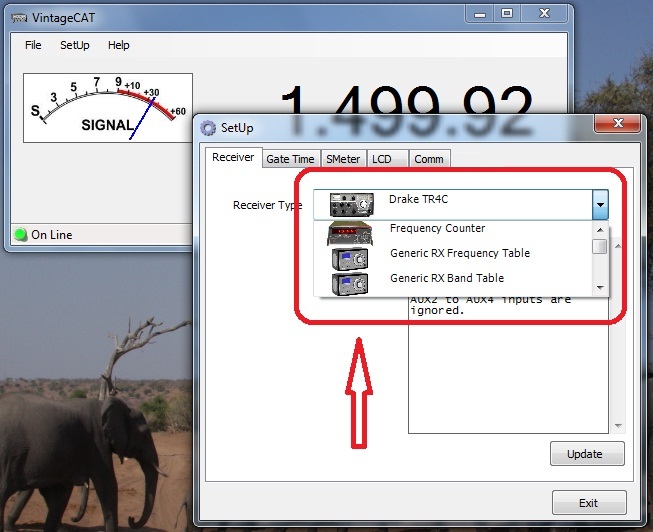VintageCAT project:
the way to add a CAT (Computer Aided Tuning) interface
to any “old style” rig
by Tony, i2tzk and Mirko, ik2mkm July 2012
VintageCAT Download
“VintageCAT” is a very simple ONE WAY interface that acquires from the rig the receiving frequency, the mode (CW, USB, LSB, etc.) and the SMeter level, digitalizes the values and sends them to the PC emulating CAT messages.
"VintageCAT" has been specially designed to interface "old tubes receivers", an optional LCD panel can show real time the receiving frequency and the mode.

Fig. 1
Any PC program that implements the Kenwood CAT protocol can communicate via the VintageCAT interface with the receiver and read the status of the rig.
Any “old style” radio without CAT option can be connected to VintageCAT and interfaced to the PC.
Hardware main features:
- A smart and cheap hardware collects from the rig:
- Vfo receiving frequency: A high impedance front end has been designed to achieve great noise immunity.
- Modes and bands: 6 inputs are available for modes (CW, USB, LSB, FM, AM, FSK) and up to 9 auxiliary input for bands. All inputs are opto-isolated to prevent high voltages or rapidly changing voltages from damaging the interface components and the PIC ports.
- S-Meter level: from S0 to S9+60.
- Microcomputer Microchip 18F2550 takes care to digitalize, elaborate frequency, mode and SMeter level and to respond to the PC commands.
- USB port to communicate with the PC emulating a virtual serial port.
- +5Volt supply is extracted from the PC USB port or from an external power supply for stand-alone operations.
- TCXO oscillator guaranties the clock stability and precision to readout +/- 1Hz
- Optional LCD to display the receiver frequency.
Firmware:
- Counter to measure the VFO frequency selectable at +/-1Hz or +/-10Hz accuracy.
- Automatic addition/subtraction of the IF offset based on selectable algorithms.
- AD conversion of the SMeter voltage 10bits accuracy adjusted and converted as required by the Kenwood CAT protocol.
- Detection of 6 receiving modes: CW, USB, LSB, FM, AM, FSK.
- Optional up to 9 auxiliary inputs that could be used for bands selection if required by the computational frequency algorithm.
- Emulate the Kenwood CAT protocol commands: read frequency, read mode and SMeter level.
- A bootloader for any further f/w upgrade without the usage of a pic programmer has been integrated into the source code.
Software:
- Dedicate Windows program to setup IF offset algorithm, SMeter minimum level and other parameters.
- Dedicate Windows program to display the receiving frequency, mode and SMeter level.
- Any PC program that implements the Kenwood CAT protocol can communicate with VintageCAT and read the status of the radio.

Fig. 2
Dedicate application “VintageCAT.exe” has been developed to read and display from the rig the receiving frequency, mode and SMeter level

Fig.3
Any PC program that implements the Kenwood CAT protocol can communicate via the VintageCAT interface with the receiver and read the rig status.

Fig. 4
Displaying the correct receiver frequency depends on several parameters.
Basically the signal that feeds VintageCAT interface could be taken from the Vfo, first or second mixer or any circuit block depending on the receiver layout, so different methods must be used to readout exactly the tuned frequency.
To allow the usage of VintageCAT with a largest number of receivers, several algorithms have been implemented.
List includes three “general purpose” methods:
· Frequency Counter. Use this one if no adjustment is needed, the counter will show exactly the frequency of the input signal.
· Generic Frequency Table. Use this one when different offsets must be applied depending on the range of the input frequency.
· Generic Band Table. Use this one when each band requires a different offset or you want manually select the offset.
and two dedicate Drake C line :
· Drake R4C
· Drake TR4C

Fig.5
